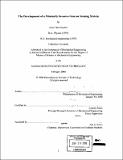The development of a minimally invasive glucose sensing system
Author(s)
Sambol, Lisa Ellen, 1974-
DownloadFull printable version (8.978Mb)
Other Contributors
Massachusetts Institute of Technology. Dept. of Mechanical Engineering.
Advisor
Lynette Jones.
Terms of use
Metadata
Show full item recordAbstract
The overall goal of this research is to develop a minimally invasive glucose sensing system for diabetic patients. The device will consist of an array of micro-needles that penetrates only the stratum corneum layer of the skin and tests glucose levels in the interstitial fluid (IF). This device does not reach the depth of the nerve endings, and so provides a painless means of glucose measurement. Glucose will be detected amperometrically using a two step chemical process in which glucose is broken down into hydrogen peroxide which is then oxidized to provide a current. By coating the outer surface of the micro-needle array with layers of rhodium, cellulose acetate, and glucose acetate using electrochemical deposition, the needles can be sensitized to the presence of glucose. Successful work has been completed in which needle surfaces were sensitized to glucose by layering the reaction catalyst (glucose oxidase) and cellulose acetate onto rhodium coated 0.51 mm diameter stainless steel wires. This was achieved through a combination of galvanostatic depositions and dip coatings. These sensors were able to detect various concentrations of glucose within the biological range (0-20 mM). Microneedles arrays have been fabricated from stainless steel and coated with rhodium in order to sensitize the surface to hydrogen peroxide. The array design increases the probability that the micro-needles will reach the IF rather than become embedded in the surrounding epithelial cells. The array design also increases the sensor surface area, thus yielding higher amperometric response signals. Other benefits of microelectrodes such as faster response times, higher signal to noise ratios, and lower sensitivity to convection are amplified when micro-needles are used in an array format. Future work on this device will be to integrate the glucose sensor with the array design to create a microneedle array that can effectively measure glucose levels in IF.
Description
Thesis (S.M.)--Massachusetts Institute of Technology, Dept. of Mechanical Engineering, 2000. Includes bibliographical references (leaves 87-93).
Date issued
2000Department
Massachusetts Institute of Technology. Department of Mechanical EngineeringPublisher
Massachusetts Institute of Technology
Keywords
Mechanical Engineering.